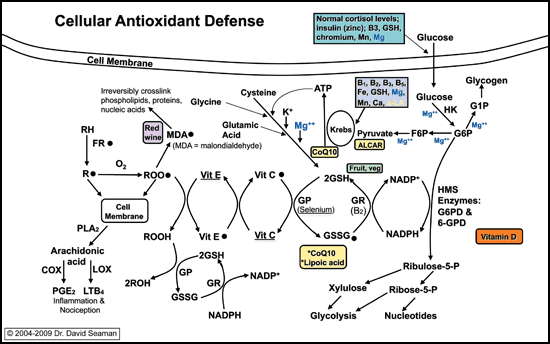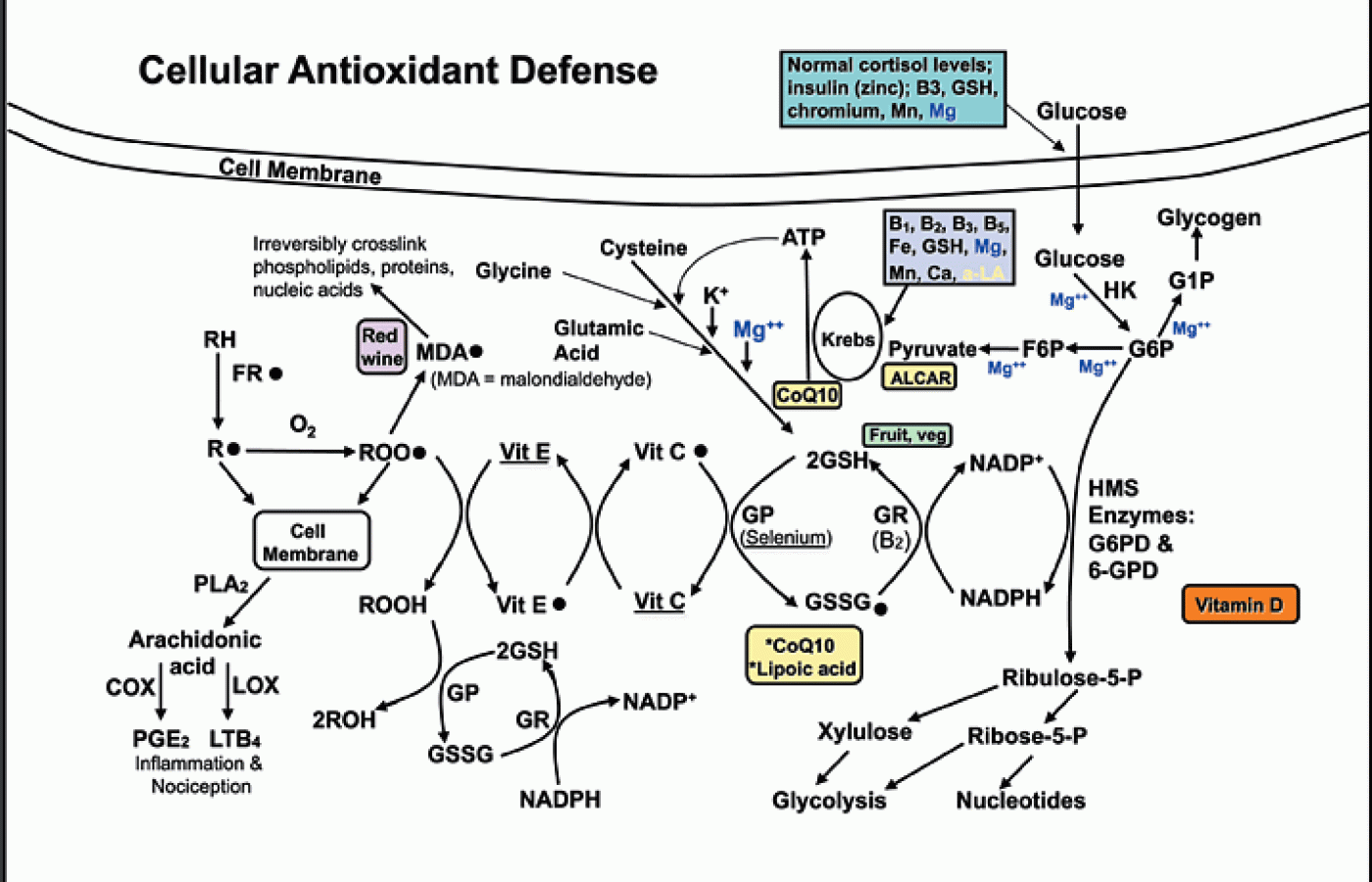Some doctors thrive in a personality-based clinic and have a loyal following no matter what services or equipment they offer, but for most chiropractic offices who are trying to grow and expand, new equipment purchases help us stay relevant and continue to service our client base in the best, most up-to-date manner possible. So, regarding equipment purchasing: should you lease, get a bank loan, or pay cash?
Why Do Antioxidant Trials Fail?
In recent years, trials with antioxidants have been disappointing, particularly to those who expect supplementation with vitamins E and C, and the mineral selenium, to prevent disease or reduce mortality. Dr. G. Douglas Andersen has nicely outlined some of the details.1 I am not surprised by these outcomes. The failure of certain glucosamine trials will serve as an example of why I am not surprised by the lack of success in antioxidant supplement trials.
First, the vast majority of glucosamine/chondroitin trials have been done on osteoarthritis (OA) of the knee. The standard recommendations for glucosamine/chondroitin are 1,500 mg/day and 1,200 mg/day, respectively. This represents approximately 3 grams of carbohydrate (glucosamine and chondroitin are made from glucose), which amounts to about 12 calories. When I envision trying to reduce chronic OA pain and joint-space narrowing with a meager 12 calories worth of a chondroprotective agent, I can only see a failed outcome.
What is not reported in the popular press about the various glucosamine studies is that a predictor for successful outcome is body mass index (BMI).2 The study that demonstrated the best outcomes in terms of pain reduction and joint-space protection involved subjects with average age of 62 and a BMI of about 25.7, which means they were just barely overweight.3 The study with the next best outcome involved 66-year-old subjects with an average BMI of 27.3.4
The most recently published study looked at OA knee pain and the follow-up study looked at joint-space narrowing.5,6 What most don't know is that these subjects averaged 60 years of age with a BMI of 31.7, which means they were obese. Normal BMI is considered to be 18.5 to 24.9. For me to be one of these subjects, I would have to age 12 years and add a whopping 75 pounds of fat to my body - and I should expect 12 calories of a chondroprotective sugar molecule to help me?
And how would I manage to gain 75 pounds of fat? I would eat the standard pro-inflammatory American diet, in which approximately 80 percent of my calories comes from refined sugar, grains (flour) and oils, and obese meat. This type of diet is known to drive most chronic diseases.7
Why Do Antioxidant Trials Fail?
No one knows the precise answer to this question. More importantly, no one doing antioxidant studies asks if supplementing antioxidants to a pro-oxidative and pro-inflammatory diet is a reasonable way to assess antioxidant efficacy. Atherosclerosis and diabetes are now known to be inflammatory diseases.8 Insulin insensitivity is thought to be a promoter of both diabetes and atherosclerosis: "Evidence at present favors chronic inflammation as a trigger for chronic insulin insensitivity, rather than the reverse situation."9
Those of us trained in manual care tend to view inflammation as an outcome of cell damage; the dead cells cause acute inflammation. However, living cells perpetuate inflammation, and the best way to turn our bodies into inflammation-producing machines is to eat the typical American diet: "The highly processed, calorie-dense, nutrient-depleted diet favored in the current American culture frequently leads to exaggerated supraphysiological post-prandial spikes in blood glucose and lipids. This state, called post-prandial dysmetabolism, induces immediate oxidant stress [free-radical production], which increases in direct proportion to the increases in glucose and triglycerides after a meal."10
Vitamins E and C, and selenium have antioxidant functions, which is why they are used in trials. However, what is not generally appreciated is that after vitamins E and C do their antioxidant activity, they become free radicals. Selenium functions as a cofactor for glutathione peroxidase, and the activity of this enzyme leads to the production of oxidized glutathione (GSSG), which is also a free radical. Oxidized glutathione and vitamins E and C must be reduced back to their antioxidant state or they add to the body's free-radical burden.
Maintaining proper blood sugar is the primary way that we support the reduction of the radical forms of E, C and glutathione. However, the average American diet promotes free radicals. So, I would expect that taking supplements which become pro-oxidants would be detrimental in certain patients.
How to Properly Reduce Free Radicals
The popular use of supplemental C, E and selenium is probably not the best way to go. Supplemental glutathione is also inappropriate; no evidence suggests that oral glutathione has any appreciable effect. In fact, both coenzyme Q10 and lipoic acid function, in part, to regenerate vitamins C, E and glutathione, and the best evidence we have suggests that coenzyme Q10 and lipoic acid should be the key supplemental antioxidant nutrients.11-14
First, we want to restore proper blood sugar regulation. It seems that hyperglycemia influences insulin-sensitive tissues, such as muscle cells, very differently compared with non-insulin-sensitive cells such red blood cells, endothelial cells, and white blood cells. Hyperglycemia is associated with less glucose entry into muscle cells and inappropriate glucose entry into non-insulin-sensitive cells. The outcome is free-radical production by each cell type. When blood sugar overwhelms the non-insulin-sensitive cells, the mitochondria are overwhelmed, so calorie restriction is important.15,16 Muscle mitochondria function is also preserved by calorie restriction.17

The figure illustrates the nutrients involved in antioxidant metabolism. Black dots denote a free radical; you can see that vitamins E and C become free radicals, as does GSSG. Notice also that vitamin E, C and the mineral selenium are underlined, and we can see that these nutrients are only part of this antioxidant system. This image does not depict the totality of antioxidant metabolism, but is reflective of many activities.11-13,15-16
In the case of muscle cells, blood sugar entry is needed to drive antioxidant metabolism and is dependent upon a host of nutrients. Magnesium is highlighted in blue to highlight that it is needed to get glucose into muscle cells and help convert it to ATP, which is needed to support the glutathione system (2GSH-GSSG).
Once glucose enters muscles and other cells, the antioxidant system appears to have similar needs. The goal is to protect cell membranes and proteins from oxidation. Vitamins E and C and glutathione can play a first-line role, but after they become free radicals, they need to be reduced. This is where proper blood sugar regulation and other key nutrients play a role.
The production of ATP, which supports the glutathione system, requires B vitamins, magnesium, lipoic acid, coenzyme Q10 and acetyl-L-carnitine (ALCAR), so these represent reasonable supplement choices.11-14,18 As mentioned above and illustrated, CoQ10 and lipoic acid have a direct antioxidant effect on the glutathione system as well.
In a recent study, it was determined that vitamin D influences the activity of the hexose monophosphate shunt, and so may have an antioxidant effect by help to produce NADPH, which is needed to reduce GSSG.19 More research is needed in this regard; however, we already know that vitamin D modulates some 1,000 genes, and adequate levels are associated with substantial disease protection.
Overeating is the most significant promote of free-radical production, so appropriate calorie intake is the primary way to reduce such production. Vitamins E, C, selenium and glutathione are key players in antioxidant metabolism; however, they cannot function unless they are regenerated. Thus, taking them as supplements without concern for calorie intake and other key nutrients may be the reason for the recent disappointing supplemental trials.
Consider instead the available evidence for supplementing with magnesium, coenzyme Q10, lipoic acid, ALCAR and vitamin D, as they offer multiple beneficial effects. With our trying economic situation in mind, it is smart to get the best bang for our buck; taking supplements that have both ATP-driving and antioxidant benefits seems to be a reasonable option.
References
- Andersen GD. "Vitamins C, E and Selenium Disappoint in Major Randomized Trials." Dynamic Chiropractic, April 9, 2009;27(8).
- Bennett AN, Crossley KM, Brukner PD, Hinman RS. Predictors of symptomatic response to glucosamine in knee osteoarthritis: an exploratory study. Br J Sports Med, 2007;41:415-9.
- Pavelka K, Gatterova J, Olejarova M, et al. Glucosamine sulfate use and delay of progression of knee osteoarthritis: a 3-year, randomized, placebo-controlled, double-blind study. Arch Intern Med, 2002;162:2113-23.
- Reginster JY, Deroisy R, Rovati LC, et al. Long-term effects of glucosamine sulphate on osteoarthritis progression: a randomised, placebo-controlled clinical trial. Lancet, 2001;357:251-6.
- Clegg DO, Reda DJ, Harris CL, et al. Glucosamine, chondroitin sulfate, and the two in combination for painful knee osteoarthritis. N Eng J Med, 2006;354:795-808.
- Sawitzke AD, Shi H, Finco MF, et al. The effect of glucosamine and/or chondroitin sulfate on the progression of knee osteoarthritis. Arthritis Rheumatol, 2008;58:3183-91.
- Cordain L, Eaton SB, Sebastian A, et al. Origins and evolution of the Western diet: health implications for the 21st century. Am J Clin Nutr, 2005;81:341-54.
- Ross R. Atherosclerosis-an inflammatory disease. N Eng J Med, 1999;340(2):115-26.
- Grimble RF. Inflammatory status and insulin resistance. Curr Opin Clin Nutr Metab Care, 2002;5:551-9.
- O'Keefe JH, Gheewala NM, O'Keefe JO. Dietary strategies for improving post-prandial glucose, lipids, inflammation, and cardiovascular health. J Am Coll Cardiol, 2008;51(3):249-55.
- Crane FL. Biochemical functions of coenzyme Q10. J Am Coll Nutr, 2001;20(6):591-8.
- Sen CK, Packer L. Thiol homeostasis and supplements in exercise. Am J Clin Nutr, 2000;72(2 Suppl):653S-69S.
- Wollin SD, Jones PJ. Alpha-lipoic acid and cardiovascular disease. J Nutr, 2003;133:3327-30.
- Linnane AW, Zhang C, Yarovaya N, et al. Human aging and global function of coenzyme Q10. Ann N Y Acad Sci, 2002;959:396-411.
- Ceriello A. New insights on oxidative stress and diabetic complications may lead to a "causal" antioxidant therapy. Diabetes Care, 2003;26(5):1589-96.
- Evans JL, Goldfine ID, Maddux BA, Grodsky GM. Oxidative stress and stress-activated signaling pathways: a unifying hypothesis of type 2 diabetes. Endocrin Rev, 2002;23:599-622.
- Conley KE, Marcinek DJ, Villarin J. Mitochondrial dysfunction and age. Curr Opin Clin Nutr Metab Care, 2007;10:688-92.
- Ames BN. Low micronutrient intake may accelerate the degenerative diseases of aging through allocation of scarce micronutrients by triage. Proc Nat Acad Sci, 2006;103(47):17589-94.
- Bao BY, Ting HJ, Hsu JW, Lee Ye. Protective role of 1-alpha, 25-dihydroxyvitamin D3 against oxidative stress in nonmalignant human prostate epithelial cells. Int J Cancer, 2008;122(12):2699-706.



